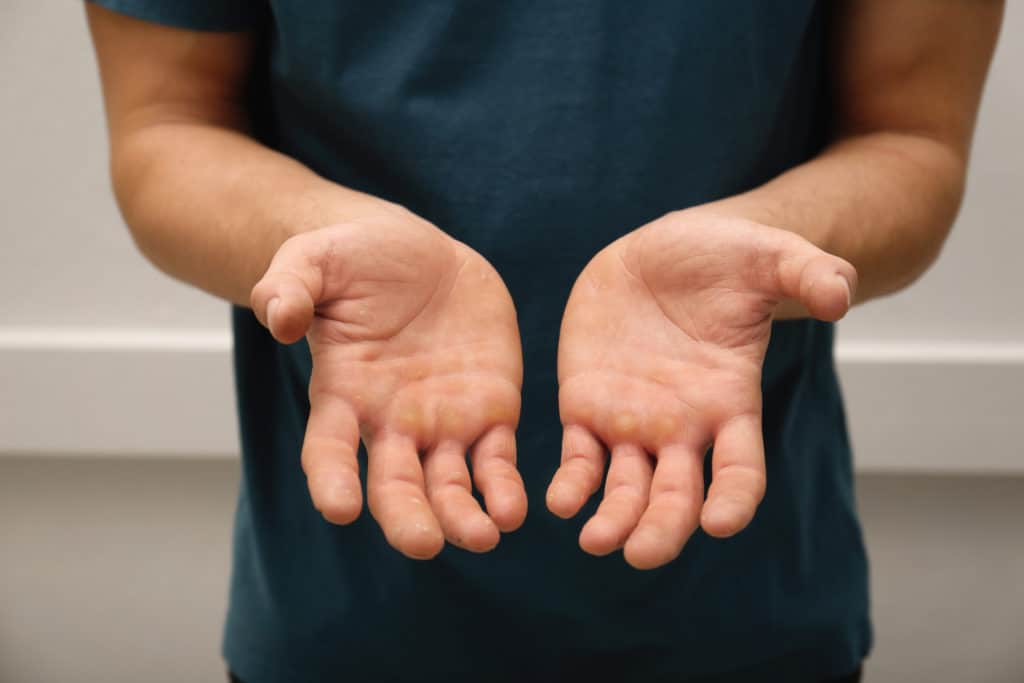Calluses are a common skin condition that can develop on hands due to repetitive friction or pressure. While calluses can offer some protection, they can also be unsightly and uncomfortable.
Here Is How You Can Help Calluses On Hands:
If you’re looking to soften calluses on your hands, there are several ways to do so safely and effectively.
The easiest methods are Soaking and using a effective Barrier cream.
In this blog, we’ll explore some of the most popular methods for removing calluses from hands, including natural remedies, over-the-counter treatments, and professional options. Whether you’re a gym-goer, a manual labourer, or simply someone who wants to have smooth, healthy-looking hands, this blog is for you. So, let’s get started!

What Is A Callus?
A callus is a thickened and hardened area of skin that develops as a result of repeated friction or pressure. Calluses typically form on the hands, feet, or other parts of the body that are subjected to repetitive stress or irritation. They serve as a natural protective barrier for the skin, but can sometimes become uncomfortable or unsightly. While calluses are generally harmless, they can be removed through various treatments if desired.
-
Kreme Plus 150gm$37.00
What Causes Calluses To Form On The Hands:
Weightlifting
1. When lifting weights, the skin on your hands is subjected to repeated friction and pressure from the equipment, such as barbells, dumbbells, or kettle bells.
2. Over time, this repetitive stress can cause the skin to thicken and harden in the areas where it comes into contact with the equipment, forming a callus.
3. Calluses can be more likely to develop if you grip the equipment too tightly or use incorrect lifting form, leading to additional stress on the skin of your hands.
4. Calluses may also be more common on certain areas of the hands, such as the palms, fingers, or knuckles, depending on which muscles you’re targeting during your weightlifting routine.
5. While calluses can provide a protective layer for the skin, they can also become uncomfortable or even painful if they get too thick, crack, or develop into blisters.
To prevent calluses from forming or becoming too severe, it’s important to take care of your hands by using gloves or grips to protect your skin, maintaining proper lifting form, and keeping your hands moisturized to prevent dryness and cracking.

Trades Including Building
1. Trade work, such as building, involves using hand tools and handling rough materials that can cause friction and pressure on the skin of the hands.
2. When handling tools like hammers, saws, or drills, the repeated impact and pressure can cause the skin to thicken and harden over time, forming calluses.
3. Handling rough materials, such as wood, metal, or concrete, can also lead to the development of calluses as the skin is subjected to abrasion and pressure from these materials.
4. Calluses may form in different areas of the hands depending on the specific tasks involved in trade work. For example, calluses may form on the palms from gripping tools or carrying heavy loads, on the fingers from handling materials, or on the knuckles from repetitive impact with surfaces.
5. While calluses can offer some protection for the skin, they can also become uncomfortable or painful if they get too thick or if they crack or blister.
To prevent calluses from forming or becoming too severe, it’s important to use protective gloves when handling tools or materials, take breaks to rest the hands, use tools with ergonomic handles that reduce pressure on the hands, and keep the skin moisturized to prevent dryness and cracking.
Playing Musical Instruments
Playing musical instruments can put a lot of pressure and friction on the skin of the hands, especially the fingers.
1. Stringed instruments, such as guitars, violins, and cellos, require pressing down on the strings with the fingers to create the notes and chords, which can cause the skin to thicken and harden in those areas.
2. Wind instruments, such as saxophones, trumpets, and clarinets, require holding and pressing keys or valves with the fingers, which can also lead to the formation of calluses.
3. Percussion instruments, such as drums and marimbas, can cause calluses to form on the hands and fingers due to the repetitive striking of the drumsticks or mallets against the drumheads or bars.
4. Calluses may form in different areas of the hands depending on the specific instrument and playing technique involved. For example, calluses may form on the fingertips from pressing down on the strings, on the pads of the fingers from pressing keys or valves, or on the palms from gripping drumsticks.
5. While calluses can provide some protection for the skin, they can also become uncomfortable or painful if they get too thick or if they crack or blister.
To prevent calluses from forming or becoming too severe, it’s important to use properly fitted instruments and equipment, take breaks to rest the hands, use tools with ergonomic handles that reduce pressure on the hands, and keep the skin moisturized to prevent dryness and cracking.

Ways To Help Callused Hands
Soaking Method
Here are some ways to fix callused hands using the soaking method:
Warm Water Soak: Fill a bowl or basin with warm water and soak your hands for 10-15 minutes to soften the calluses. You can add a few drops of essential oil or Epsom salt to the water to enhance the relaxing effect.
Exfoliating Scrub: After soaking, gently exfoliate the calluses with a pumice stone, foot file, or exfoliating scrub. This will help remove the dead skin cells and reduce the thickness of the calluses.
Moisturize: Apply a moisturizer or hand cream to your hands after exfoliating. This will help hydrate the skin and prevent the calluses from becoming too dry or cracking.
Repeat: Repeat this soaking, exfoliating, and moisturizing routine daily or as needed until the calluses have been reduced to your liking. Be sure to avoid cutting or shaving the calluses, as this can lead to infection or further damage to the skin.
Consider professional treatment: If the calluses are severe or causing discomfort, you may want to consider professional treatment options, such as a medical pedicure or callus removal treatment by a dermatologist or podiatrist.
Barrier Cream
Here are some ways to fix callused hands using a barrier cream:
Choose the right barrier cream: Look for a barrier cream that contains ingredients like beeswax, which can help protect the skin and lock in moisture.
Apply the cream before activities: Apply the barrier cream to your hands before engaging in activities that can cause calluses, such as weightlifting or manual labor. This will help reduce friction and prevent calluses from forming.
Reapply as needed: Reapply the cream throughout the day, especially after washing your hands or engaging in activities that can dry out the skin.
Wear gloves: Consider wearing gloves when engaging in activities that can cause calluses, such as weightlifting or manual labor. The gloves can provide an extra layer of protection and reduce friction on the skin.
Keep the skin moisturized: Even when using a barrier cream, it’s important to keep the skin moisturized to prevent dryness and cracking. Apply a hand cream or moisturizer to your hands after washing or as needed throughout the day.
Seek professional treatment: If the calluses are severe or causing discomfort, you may want to consider professional treatment options, such as callus removal treatment by a dermatologist or podiatrist. A barrier cream may not be enough to address the issue in these cases.



